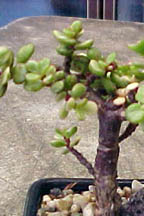
In the Garden![]()
Michael Miyashiro
Succulents can flourish
in miniatureSummer 2004 will be a hot one, meteorologists claim. For the gardener, this means frequent watering and some plant replacement due to the sun's heat and light exposure.
Some plants look forward to this hot time of year, actively growing and flowering, including succulents planted in miniature or bonsai-like containers.
Most succulents are well adapted to growing in small-root capacities. Many of these plants find suitable natural habitats in rock crevices or cliff faces. This natural adaptation allows these plants to grow in some abrupt conditions.
How do these plants do so well in these extreme conditions? First, one must understand the role of photosynthesis in these peculiar plants. Succulents and other dry-growing plants -- Tillandsias, some orchids, etc. -- possess the ability for CAM photosynthesis. CAM, or Crassulacean Acid Metabolism, basically allows plants to hold onto their water during extreme heat and light conditions, and photosynthesize at night when it's cooler. The process is more intricate than this, but basically, this mechanism is their key to success when most other plants dry up or wilt.
Bonsai culture is like growing plants in crevices. The key elements in culture is to water sparingly, feed in small or dilute amounts, and expose to high light intensities. This causes plants to reduce their surface area quickly, producing smaller growths and shedding large unnecessary ones. Many produce thickened stem or root features that make the plants resemble old bonsai subjects.
Almost any succulent can become a succulent bonsai. You just need imagination, the right container and the rest is up to culture.
Use any good potting mixture that is well draining, a fertilizer low in salts, and a growing spot with high light and heat potential. Some plants need to adjust to these extremes, but after gradual transferring, the plants just love it.
Although these cute plants might look good in the office or home, keeping these plants "cute" is a matter of exposure to hard treatment. You may enjoy them a few days indoors, but if kept inside too long, new growths with exaggerated stem and leaf proportions will dwarf and ruin your miniaturization effort.
Pruning is also a key feature in making these plants conform to a bonsai culture. Prune hard and remove whole stems and leaves that are not part of your bonsai scheme. After a while, your plant will look like it's a hundred years old and not even a year has gone by.
Michael Miyashiro owns Rainforest at Ward Warehouse. Contact him at 591-9999 or e-mail rainforesthawaii@aol.com. "In the Garden" is a Friday feature.
Gardening Calendar


